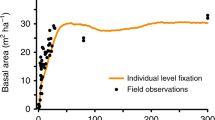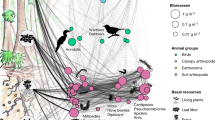Abstract
Predatory plants are typically found in discrete groups living under conditions of extreme nutrient stress. But we show here how a common species of boreal tree can act indirectly as a predator of arthropods living in the soil by virtue of a fungal symbiont that supplies it with animal nitrogen in exchange for the plant's carbon. If the way in which this partnership operates proves to be widespread, ideas about nutrient cycling1,2 and food-web dynamics3 in temperate forests may have to be modified.
This is a preview of subscription content, access via your institution
Access options
Subscribe to this journal
Receive 51 print issues and online access
$199.00 per year
only $3.90 per issue
Buy this article
- Purchase on Springer Link
- Instant access to full article PDF
Prices may be subject to local taxes which are calculated during checkout


Similar content being viewed by others
References
Schlesinger, W. H. Biogeochemistry: An Analysis of Global Change (Academic, San Diego, 1991).
Simard, S. W. et al. Nature 388, 579–582 (1997).
Moore, J. C., Walter, D. E. & Hunt, H. W. Annu. Rev. Entomol. 33, 419–439 (1988).
Smith, S. E. & Read, D. J. Mycorrhizal Symbiosis (Academic, San Diego, 1997).
Fitter, A. H. & Sanders, I. R. in Mycorrhizal Functioning, an Integrative Plant–Fungal Process (ed. Allen, M. F.) 333–354 (Chapman & Hall, New York, 1992).
Barron, G. L. & Thorn, R. G. Can. J. Bot. 65, 774–778 (1987).
Author information
Authors and Affiliations
Corresponding author
Rights and permissions
About this article
Cite this article
Klironomos, J., Hart, M. Animal nitrogen swap for plant carbon. Nature 410, 651–652 (2001). https://doi.org/10.1038/35070643
Issue Date:
DOI: https://doi.org/10.1038/35070643
This article is cited by
Comments
By submitting a comment you agree to abide by our Terms and Community Guidelines. If you find something abusive or that does not comply with our terms or guidelines please flag it as inappropriate.



